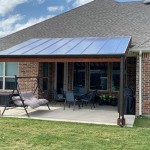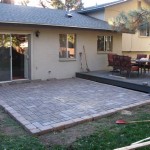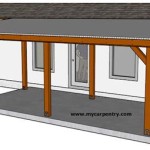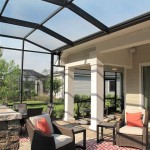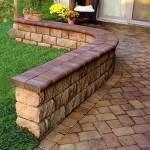Bringing Spanish Style to Your Patios
Spanish style patios evoke images of sun-drenched afternoons, vibrant colors, and a relaxed, communal atmosphere. Imbued with a rich history influenced by Moorish, Mediterranean, and indigenous cultures, Spanish design principles offer a compelling aesthetic for outdoor living spaces. This article explores key elements of Spanish design and provides practical guidance on how to incorporate them into any patio, regardless of size or existing style.
Successfully integrating Spanish design goes beyond simply adding a few terracotta pots. It requires an understanding of the underlying principles that define this aesthetic. This includes a consideration of color palettes, materials, furniture choices, landscaping, and the overall flow of the space. A cohesive design will create a patio that is both visually appealing and functional, providing a welcoming area for relaxation, dining, and entertaining.
Key Point 1: Embracing Warm Earth Tones and Vibrant Accents
Color plays a crucial role in establishing the Spanish aesthetic. The foundation typically consists of warm, earthy tones that reflect the natural landscape of Spain. Think of colors like terracotta, ochre, sand, and various shades of brown. These hues create a sense of grounding and provide a neutral backdrop for bolder accent colors.
Terracotta is particularly significant. This reddish-brown clay is widely used in Spanish architecture and design, appearing in tiles, planters, and decorative elements. Its natural warmth and texture add an authentic touch to any patio. Consider using terracotta tiles for flooring or incorporating terracotta pots of varying sizes to house plants.
While earth tones form the base, vibrant accent colors inject personality and energy into the space. Bold blues, yellows, reds, and greens are commonly used to complement the neutral backdrop. These colors can be introduced through various elements, such as cushions, rugs, decorative tiles, and painted furniture. Cobalt blue, in particular, is frequently seen in Spanish designs and can be used to create a striking visual impact.
The interplay between the neutral base and the vibrant accents is crucial for achieving the desired effect. Avoid overwhelming the space with too many bold colors. Instead, use them strategically to create focal points and add visual interest. For example, a brightly colored outdoor rug can define a seating area, while a string of colorful lanterns can add a festive touch.
Consider using a color wheel to help select accent colors that complement the dominant earth tones. Analogous colors (those that are next to each other on the color wheel) can create a harmonious and cohesive look, while complementary colors (those that are opposite each other on the color wheel) can create a more dramatic and visually stimulating effect. Ultimately, the choice of accent colors should reflect personal preferences and the desired mood of the patio.
Key Point 2: Utilizing Natural Materials and Textures
Spanish design emphasizes the use of natural materials that connect the space to the environment. These materials not only contribute to the aesthetic appeal but also add texture and depth to the patio. The key materials include stone, wood, wrought iron, and ceramic.
Stone is a fundamental element of Spanish architecture and can be incorporated into various aspects of the patio. Stone pathways, retaining walls, and even stone-topped tables can add a rustic and authentic touch. Consider using local stone varieties to further enhance the connection to the surrounding landscape. Different types of stone, such as flagstone, slate, and limestone, offer varying textures and colors to suit different design preferences.
Wood adds warmth and natural beauty to the patio. Wooden furniture, pergolas, and decking can create a welcoming and inviting atmosphere. Opt for durable wood species that can withstand the elements, such as teak, cedar, or redwood. Consider using reclaimed wood to add character and a sense of history to the space. Wooden beams and columns can also be incorporated to create a more architectural feel.
Wrought iron is another defining element of Spanish design. It is commonly used for furniture, gates, railings, and decorative accents. Wrought iron adds a touch of elegance and sophistication to the patio. Look for pieces with intricate designs and scrollwork to further enhance the Spanish aesthetic. Wrought iron furniture is also highly durable and can withstand the elements for many years.
Ceramic tiles, particularly those with hand-painted designs, are a prominent feature of Spanish design. They can be used for flooring, backsplashes, and decorative accents. Look for tiles with traditional Spanish motifs, such as floral patterns, geometric designs, and scenes from daily life. Handmade tiles, while more expensive, offer a unique and authentic touch that cannot be replicated by mass-produced alternatives.
Combining these natural materials in a thoughtful and harmonious way is essential for creating a successful Spanish-style patio. The interplay of different textures and colors will add depth and visual interest to the space. Consider incorporating elements like woven baskets, linen fabrics, and rope accents to further enhance the natural aesthetic.
Key Point 3: Designing for Shade, Water Features, and Lush Landscaping
Spanish patios are designed to provide respite from the sun and create a comfortable outdoor living space. Shade, water features, and lush landscaping are integral components of this design philosophy. These elements not only enhance the aesthetic appeal but also contribute to the overall functionality and enjoyment of the patio.
Providing adequate shade is crucial for creating a comfortable outdoor space, especially in warm climates. Pergolas, awnings, and umbrellas are common solutions for providing shade on a Spanish-style patio. Pergolas can be covered with climbing plants, such as bougainvillea or wisteria, to create a natural and visually appealing shade structure. Awnings can be retractable to allow for flexibility in controlling the amount of sunlight entering the patio. Umbrellas can be easily moved to provide shade where needed.
Water features are frequently incorporated into Spanish patios to add tranquility and a sense of serenity. Fountains, ponds, and even small waterfalls can create a soothing soundscape and enhance the overall ambiance of the space. Consider using traditional Spanish-style fountains made from terracotta or stone. Adding aquatic plants, such as water lilies and papyrus, can further enhance the natural beauty of the water feature.
Lush landscaping is essential for creating a vibrant and inviting Spanish-style patio. Plants commonly used in Spanish gardens include citrus trees, olive trees, lavender, rosemary, and bougainvillea. These plants are not only visually appealing but also fragrant and provide a connection to the Mediterranean landscape. Incorporating potted plants of varying sizes and heights can add depth and visual interest to the patio.
The use of terracotta pots is particularly important in Spanish landscaping. Terracotta pots provide a warm and rustic touch that complements the other natural materials used in the design. Arrange the pots in clusters or groupings to create a more visually appealing and cohesive look. Consider using different sizes and shapes of pots to add variety and interest.
The integration of shade, water features, and lush landscaping is crucial for creating a truly authentic and inviting Spanish-style patio. These elements not only enhance the aesthetic appeal but also contribute to the overall functionality and enjoyment of the space. By carefully considering these design principles, it is possible to transform any patio into a sun-drenched haven that evokes the spirit of Spain.
Beyond these key points, consider the importance of outdoor lighting. String lights, lanterns, and strategically placed spotlights can create a warm and inviting atmosphere in the evening. Look for lighting fixtures that complement the overall Spanish style, such as wrought iron lanterns or terracotta sconces. The choice of furniture is also important. Wrought iron furniture, wooden benches, and comfortable cushions can create a welcoming and relaxed seating area.

Spanish Style Water Wise Front And Back Yards Garden View Landscape Nursery Pools

Spanish Sanctuary Backyard Plans Jenna Sue Design

Spanish Style Water Wise Front And Back Yards Garden View Landscape Nursery Pools

What Is Spanish Patio Design And It Right For You

Spanish Style Water Wise Front And Back Yards Garden View Landscape Nursery Pools

Spanish Sanctuary Backyard Plans Jenna Sue Design

What Is Spanish Patio Design And It Right For You

Spanish Modern Interior Design How To Blend Traditional Warmth With Contemporary Flair Decorilla

Spanish Sanctuary Backyard Plans Jenna Sue Design

What Are Spanish Style Homes A House In The Hills
Related Posts

